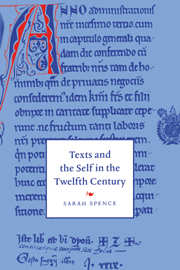Book contents
- Frontmatter
- Contents
- Acknowledgements
- 1 Corpus, body, text (and self)
- 2 Writing out the body: Abbot Suger, De administratione
- 3 Text of the body: Abelard and Guibert de Nogent
- 4 Text of the self: Guilhem IX and Jaufre Rudel, Bernart de Ventadorn and Raimbaut d'Aurenga
- 5 Writing in the vernacular: the Lais of Marie de France
- 6 Conclusion
- Works cited
- Index
- Cambridge Studies in Medieval Literature
2 - Writing out the body: Abbot Suger, De administratione
Published online by Cambridge University Press: 08 January 2010
- Frontmatter
- Contents
- Acknowledgements
- 1 Corpus, body, text (and self)
- 2 Writing out the body: Abbot Suger, De administratione
- 3 Text of the body: Abelard and Guibert de Nogent
- 4 Text of the self: Guilhem IX and Jaufre Rudel, Bernart de Ventadorn and Raimbaut d'Aurenga
- 5 Writing in the vernacular: the Lais of Marie de France
- 6 Conclusion
- Works cited
- Index
- Cambridge Studies in Medieval Literature
Summary
Chrétien de Troyes' romance, Le Conte du Graal, introduces its hero, Perceval, in the following scene:
Por la dolçor del tans serain
osta au chaceor son frain,
si le leissa aler peissant
par l'erbe fresche verdeant;
et cil qui bien lancier savoit
des javeloz que il avoit
aloit anviron lui lançant,
une ore arriere et altre avant,
une ore an bas et altre an haut,
tant qu'il oï par mi le gaut
venir. v. chevaliers armez,
de totes armes acesmez
(lines 91–102)(Because of the sweetness of the clear season he lifted the reins from the horse and let him wander in the green fresh meadow; and the one who knew how to throw the javelin went tossing it now behind, now before, now low, now high, until he heard among the brambles five armed knights arrive, bristling with all kinds of armor)
The text identifies Perceval through the phrase “cil qui bien lancier savoit” he is “the one who knew how to throw [the javelin].” Yet this activity is modified by the word ore, which helps to mark the area the javelin circumscribes, to outline the edge of the hero's extended body. Ore is admirably suited to this task of definition. While the primary meaning is indeed “now,” the fact that the word is linked so closely with spatial markers (behind, before, low, high) suggests that it also functions in spatial terms. Ore would appear, in fact, to be as much associated with the spatial placement of the javelin as with its temporal function. Perceval's identity is thus established in both spatial and temporal terms.
- Type
- Chapter
- Information
- Texts and the Self in the Twelfth Century , pp. 19 - 54Publisher: Cambridge University PressPrint publication year: 1996



